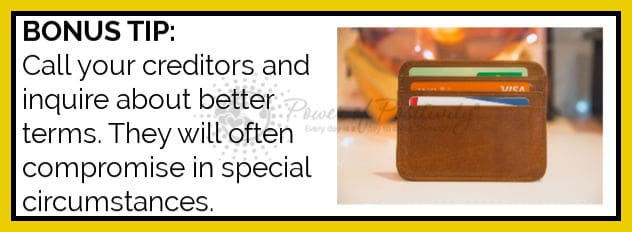Are you struggling with debt? If yes, then listing your debts, laddering them, saving, learning how to earn money online, and other strategies can make you debt-free. Here are ten things I did to pay off my debt in just one year:
1. Listing Debts by Interest Rate
When paying bills gets tough, you might be tempted to stash them away. However, the essential key to clearing your debt is identifying your position. Get all your bills and debts and make a list of the smallest to the largest ones. Then organize the list from the debts with the most interest to the ones with the least interest. Because the debt with the most interest is incurring more cost, you want to start clearing it first. Once you have your complete list of debts with their interest rates, you will be aware of what you must tackle to end struggling with debt.
2. Ladder Your Debts
After listing your debts from the one with the highest rate of interest to the one with the lowest rate of interest, start with the one with the highest rate of interest. Pay off the most you can and once you are through, pay a similar amount to the next debt with the most interest and so on. This will save you a lot of money, and after debts begin disappearing from the list, you will achieve more momentum.
3. Get an Emergency Saving Fund
Since emergencies can occur, you must prepare for them. However, saving up for an emergency should not delay your plan to clear your debts. Prior to clearing your debts, create a small emergency fund of $1000 or more for unexpected costs like medical bills, car repair, or more. This can be cash you can use when something random comes up. In case there is an emergency and you use the money, top it up before resuming debt payment. However, remember to keep paying your minimum debt payments as you top up your fund to ensure you don’t face costly penalties.
Credit cards typically have high rates of interest. Therefore, if you use your credit card to cater for an emergency, you will end up in more debt. The more the debt you get into, the more the months it will take you to clear it, and the more the debt you will pay due to higher interest rates. Additionally, you will ruin your credit score.
Keep in mind that an emergency fund includes money that needs to be easily and quickly accessible once there is an emergency. You need to keep it in a safe place like a savings account. The money won’t grow much, but accessing it will be easy and it will always be there if you need it. And, you won’t need to tap into your credit cards in an emergency and end up struggling with debt even more!
4. Make Minimum Monthly Payments
You must always ensure you meet minimum monthly payments of your debt to avoid incurring late fees and higher interest rates. The ideal way to be on par with monthly card payments is to use the closing date of the card as opposed to the due date of the payment. The closing date completes your monthly bill, and any payment after this date is part of the following month’s statement. The closing date of your card is on the statement.
The report of the card’s balance at the closing date is usually sent to the credit bureau. Hence, if you clear the balance prior to that date, your balance will be zero on your statement. This will assist you in avoiding late fees and higher interest rates in addition to improving your credit score.
5. Make a Budget and Eradicate Any Extraneous Things
Coming up with a budget is an excellent idea of staying on top of your expenses when you are struggling with debt. As much as budgeting might make you feel broke, it is a way of directing the destination of your money.
An ideal starting point is to acquire your previous month’s expenses from a credit card or bank statements. Use an Excel spreadsheet or a paper budget to organize your expenses. Also, use an app such as Mint to budget your costs. You will need to come up with categories for every expense to create a limit to that expense and indicate your income. Ensure that your income always exceeds your budget. In case it happens, consider cutting some items from the budget.
If it becomes hard to use a computer or paper to budget, you could go for the envelope method. This is a traditional money management method that some people still use to control their spending. In this method, you make payments in cash for every expense you can, using envelopes to hold the money and maintain the budget.
6. Downsizing Temporarily
Paying off debt does not happen forever. It is kind of delayed gratification that will enable you to enjoy a life free of debt. Look at the expenses of your previous month and look for things that are not essentials. It could be eating out, entertainment, monthly subscription services, and so on. Do away with these expenses temporarily and then use the savings to clear out more debt.
7. Increase Your Income
After organizing your debts and creating a budget, the next step is to increase your income. You can do this by looking for a higher paying job. You can also apply for more senior positions at our current company. Additionally, you can acquire a second job so that you can make more money. You can also look into how to earn money online.
Getting a promotion or another job might take a while or prove difficult. But do you know how to earn money online by utilizing a skill you have? If you are an application programmer or a web designer, there are many clients online looking for someone with your particular set of skills. Registering on sites like Fiver and creating an appealing profile can aid you in landing clients who are willing to pay for your talent and you can earn money online.
You don’t need to be a web designer or an app developer to earn money online. There are jobs for hundreds of skills. 20% of the US population is working in the freelance economy with people working remotely. You can be a graphic designer, project manager, writer, or personal assistant, and there are many more ways of how to earn money online. If you don’t have any skills, you can learn the skill of your interest online in under two weeks and earn money online.
8. Transferring Balances
If you are incurring high-interest rates, transfer your balances to save and clear your debt. Make sure your minimum payments are met, and your balance is cleared prior to the expiry of the introductory interest rate. Otherwise, you will result in late fees and higher interest rates. And, you will continue struggling with debt
In case you have a challenge meeting your balances as well as the minimum payments, contact the Consumer Credit Counselling Service. They offer credit counseling for free together with debt management service at the cost of 3 to 5 percent per month without exceeding $50, depending on the state.
9. Rewarding Oneself for Small Victories
The debt payment process needs not to be a chore, and you can make it fun while you do it. Make a game out of it and offer yourself a reward whenever you hit a milestone towards ending your struggle with debt.
Each time you clear a debt, celebrate with something you like to do. These can include going to the movies, going out for coffee, buying some ice-cream, or anything that can be managed within your budget. This will motivate you to keep paying off your debt.
10. Selling Unnecessary Items to Earn Money Online
Look around your home searching for anything that is using unnecessary space because you don’t need it. It could be some massive furniture eating up your space that you can sell off to clear your debt with the money and reduce your financial obligations. You could hold a garage sale or earn money online by selling things on Facebook, eBay, Craigslist, and other sites.
eBay
eBay is the top site for selling things to earn money online. This popular online marketplace has been the best in enabling the sale of used items since the 1990s. You start by creating an account, listing your things to be sold, and uploading pictures of the items. The site offers you access to more than 160 million people. However, eBay will cost you $0.3 to list an item and 10 percent of the sale of each item.
Bonanza
Bonanza is another item you can list your used merchandise for sale. Its structure resembles eBay but with a lower list cost. You will incur a charge of 3.5 percent of the value of items below $500. If over $500, it will cost you $17.5 plus 1.5% of the sale. You can also link your items on this site to Google shopping.
Etsy
You can also earn money online by selling items through Etsy. This site specializes in the sale of handcraft merchandise and used things that are twenty years old or more. These goods are referred to as vintage, and if you have such items, you can sell them off on this site for quick money. You incur a cost of $0.2 to list and 3.5% of the sale as well as $0.25 and 3% for processing of the payment. The site has 22.6 million shoppers that can be potential clients for your vintage or handmade items. If you were wondering about how to earn money online, this is it.
Follow These Tips and Stop Struggling with Debt
Paying off your debts can be a stressful process, but if you organize your debts, budget, and earn money online, you will be able to be free of debt in no time. Knowing how to earn money online can be instrumental since you will get quick cash that can clear your debt impromptu. Earn money online and remain debt-free.










